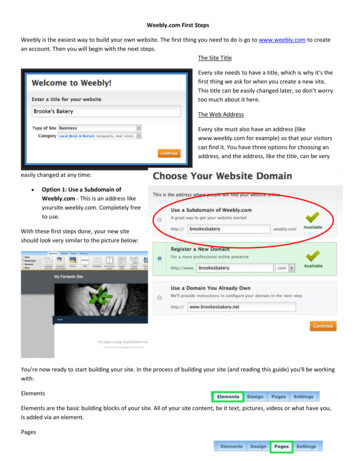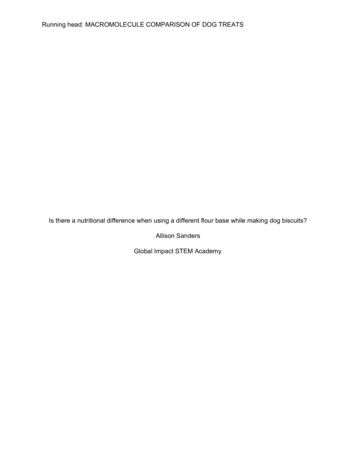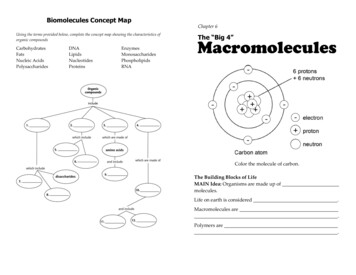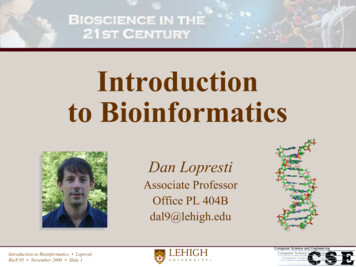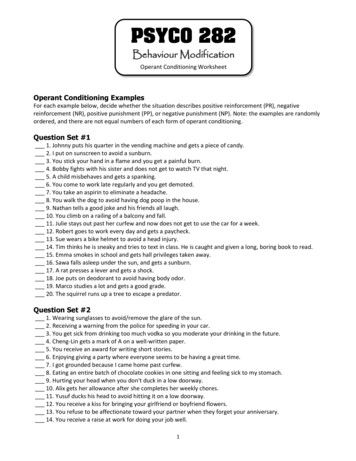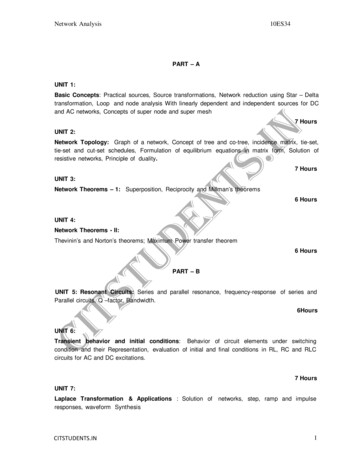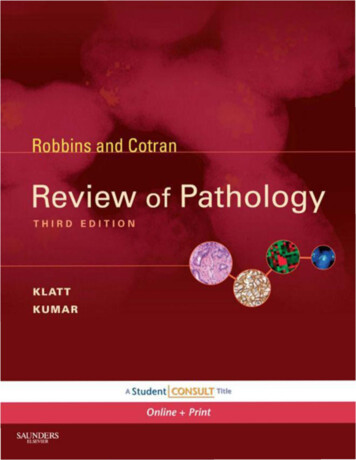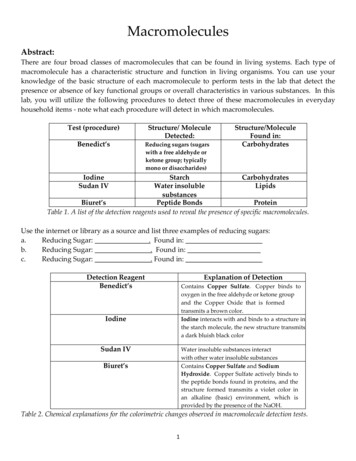
Transcription
MacromoleculesAbstract:There are four broad classes of macromolecules that can be found in living systems. Each type ofmacromolecule has a characteristic structure and function in living organisms. You can use yourknowledge of the basic structure of each macromolecule to perform tests in the lab that detect thepresence or absence of key functional groups or overall characteristics in various substances. In thislab, you will utilize the following procedures to detect three of these macromolecules in everydayhousehold items ‐ note what each procedure will detect in which macromolecules.Test (procedure)Benedict’sStructure/ MoleculeDetected:Reducing sugars (sugarswith a free aldehyde orketone group; typicallymono or disaccharides)Structure/MoleculeFound in:CarbohydratesIodineSudan IVStarchCarbohydratesWater insolubleLipidssubstancesBiuret’sPeptide BondsProteinTable 1. A list of the detection reagents used to reveal the presence of specific macromolecules.Use the internet or library as a source and list three examples of reducing sugars:a.Reducing Sugar: . Found in:b.Reducing Sugar: . Found in:c.Reducing Sugar: . Found in:Detection ReagentBenedict’sExplanation of DetectionContains Copper Sulfate. Copper binds tooxygen in the free aldehyde or ketone groupand the Copper Oxide that is formedtransmits a brown color.Iodine interacts with and binds to a structure inthe starch molecule, the new structure transmitsa dark bluish black colorIodineSudan IVWater insoluble substances interactwith other water insoluble substancesContains Copper Sulfate and SodiumHydroxide. Copper Sulfate actively binds tothe peptide bonds found in proteins, and thestructure formed transmits a violet color inan alkaline (basic) environment, which isprovided by the presence of the NaOH.Biuret’sTable 2. Chemical explanations for the colorimetric changes observed in macromolecule detection tests.1
Designing Experimental ControlsBecause you are going to be testing for the presence of different macromolecules in this lab, there areseveral important steps that you must first take to ensure that you properly interpret your results. Inorder for you to know which of the macromolecules are present in your samples, you must initiallyset up controls. Controls are samples or trials with an outcome that is already known. There arepositive controls, which give positive results (Example: In the case of the reducing sugars test, asample containing a known reducing sugar). There are also negative controls, which give negativeresults (Example: In the case of the reducing sugars test, a sample that contains no reducing sugars).For the purpose of this experiment, we have provided you with the following:1% Glucose Solution1% Egg AlbuminVegetable Oil1% Starch SolutionEach of the above mentioned solutions will be used as a positive control for one of the macromoleculetests. Using the information from above, please state the macromolecule that these controls will helpyou identify.Results:SolutionPositive Control For1% Glucose Solution1% Egg Albumin SolutionVegetable Oil1% Starch SolutionTable 3. Determination of solutions used for positive controls for each type of macromolecule.Additionally, you will want a negative control for each test. Can you think of a solution that wouldproduce a negative result for each and every one of the tests listed above?2
Further Elucidation of Lipids and Their Chemical PropertiesUnfortunately, the relative concentrations of lipids in each of the household substances are too low todetect using any kind of test available in this laboratory setting. Instead, the following experimentsare intended to further your understanding about the chemical properties of lipids. Here you willobserve the interaction between lipids and water, as well as the detection reagent that is used toindicate the lipid component of your solution. Finally, you will look at the effect that an emulsifierhas on lipids. An emulsifier is a substance that has both hydrophobic and hydrophilic properties ondifferent portions of the molecule.Answer the following questions in preparation for this experiment:Observe the lipid solution (vegetable oil) provided as your standard. Is it a saturated or unsaturatedfat? How do you know?Materials and Methods:Sudan IV (Lipids)Positive Control1)Label a test tube “L( )” (which stands for Lipids Positive Control).2)Fill the tube up to the halfway point with water.3)Add 10 drops of vegetable oil to the tube.Where is the oil in the tube?Negative Control1)Label a test tube “L(-)“ (which stands for Lipids Negative Control).2)Fill the tube up to the halfway point with water.3)Add the equivalent of 10 drops of negative control (water) to the tube.Adding the Detection Reagent to Both Tubes4)Shake the tube to mix the contents.5)Add 5 drops of Sudan IV to the tube and gently shake it again.6)Place the tube in your test tube rack7)After 5 minutes, shake each tube again.3
Compare the positive and negative control.solution from the lipid – solution?What do you see that distinguishes the lipid Notice that the Sudan IV seems to associate primarily with the lipids in the positive control tube.What does this tell you about Sudan IV and its solubility in water?Addition of an Emulsifier1.Take your tube labeled “L( )” and add a dropper full of detergent water.2.Shake the test tube vigorously.What is the emulsifier that you used in this experiment?What happens to the oil in the test tube when you add the emulsifier?What do these results tell you about the solubility of the emulsifier in water?What do these results suggest about the emulsifier’s ability to interact with the lipids?Identification of Macromolecules in Everyday ItemsIn this portion of the lab, you will make a complete set of controls to be used for comparisonpurposes when you identify macromolecules that exist in everyday items that you use or can befound at the grocery store.Materials and Methods: Benedict’s (Reducing Sugars)Positive Control:1)Label a test tube “RS( )” (which stands for Reducing Sugar Positive Control)2)Add 2 ml of Glucose solution to the tube.Negative Control:1)Label a test tube “RS(–)“ (which stands for Reducing Sugar Negative Control).2)Add 2 ml of your negative control to the tube.4
All Tubes:3)Add 2 ml of Benedict’s reagent to each tube.4)Gently shake each tube to mix the solution.5)Heat the test tubes for 3 minutes at 100 C (boiling water) in a beaker of water on your hotplate.6)Remove the tubes from the beaker and place in a test tube rack.What does a ( ) Reducing Sugar test look likeWhat does a (-) Reducing Sugar test look like:StarchPositive Control1)Label a test tube “S ( )” (which stands for Starch Positive Control).2)Add 2 ml of Starch solution to the tube.Negative Control1)Label a test tube “S (-)“ (which stands for Starch Negative Control).2)Add 2 ml of the negative control to the tube.All Tubes3)Add a dropper full of Iodine to each test tube (NOTE: A dropper full is the amount that goesup into the dropper when you fully squeeze and release the bulb).4)Gently shake the test tubes.5)Place the test tubes in your test tube rack.What does a ( ) Starch test look like:What does a (-) Starch test look like:Biuret’s (Proteins)Positive Control1)Label a test tube “P( )” (which stands for Proteins Positive Control).2)Add 2 ml of Egg Albumin to the tube.Negative Control1)Label a test tube “P(‐)“ (which stands for Proteins Negative Control).2)Add 2 ml of your negative control to the tube.All Tubes1)Add 2ml of to each tube.2)Gently shake the test tubes.3)Let the test tubes sit for 2 minutes.4)Place the tubes in your test tube rack.What does a ( ) Protein test look like:What does a (-) Protein test look like:5
4.3 Identification of Macromolecules in Household SubstancesNow you are ready to test for the presence of macromolecules in various household substances. Onthe side of the room you will find beakers containing a variety of different substances including: CornFakes, Milk, Baby Formula, Sports Drink, Chicken Broth, and Lemon Lime Soda. As a group, selectone of the solutions that you wish to test. Make your choices based on your interests! Using availablesources plus your knowledge of these solutions and what they are used for, state a hypothesisregarding what macromolecules you believe you will find in these solutions and why.NOTE: FOR THE REDUCING SUGARS TEST IN SODA AND SPORTS DRINK, RECORD THE RESULTIMMEDIATELY AFTER YOU ADD THE BIURET TO EACH SOLUTION, AND THEN MAKE NOTE OF ANYCOLOR CHANGE OBSERVED TEN MINUTES AFTER THE ADDITION OF THE BIURET.Solution 1:Write your hypothesis: will test positive for ,Because .Materials and Methods:1)Label three test tubes 1 ‐ 3.2)For test tube 1, place 2 ml of Solution 1 into test tube, follow the previously listed procedurefor detection of reducing sugars starting at Step 3.3)For test tube 2, place 2 ml of Solution 1 into test tube, follow the previously listed procedurefor detection of Starch starting at Step 3.4)For test tube 3, place 2 ml of Solution 1 into test tube, follow the previouslylisted procedure for detection of Proteins starting at Step 3.5)Record your findings for Solution 1 in the table below.Results:Solution 1:Test ForColoration/Appearance ofPositive ControlSol. 1Result( or ‐)Coloration/Appearance ofNegative ControlReducingSugars(tube 1)Starch(tube 2)Proteins(tube 3)Table 4. Determination of macromolecules present in.6Comments
Solution 2:Write your hypothesis: will test positive forBecause .Materials and Methods:1)Label three test tubes 4 - 6.2)For test tube 4, place 2 ml of Solution 2 into test tube, follow the previously listed procedurefor detection of reducing sugars starting at Step 3.3)For test tube 5, place 2 ml of Solution 2 into test tube, follow the previouslylisted procedure for detection of Starch starting at Step 3.4)For test tube 6, place 2 ml of Solution 2 into test tube, follow the previouslylisted procedure for detection of Proteins starting at Step 3.5)Record your findings for Solution 2 in the table below.Results:Solution 2:Test ForColoration/Appearance ofPositive ControlColoration/Appearance ofNegative ControlReducingSugars(tube 4)Starch(tube 5)Proteins(tube 6)Figure 5. Determination of macromolecules present inSol. 2Result( or -)Comments.Solution 3:Write your hypothesis: will test positive for ,Because .7
Materials and Methods:1)Label three test tubes 7 - 9.2)For test tube 7, place 2 ml of Solution 3 into test tube, follow the previouslylisted procedure for detection of Reducing sugars starting at Step 3.3)For test tube 8, place 2 ml of Solution 3 into test tube, follow the previously listed procedurefor detection of Starch starting at Step 3.4)For test tube 9, place 2 ml of Solution 3 into test tube, follow the previously listed procedurefor detection of Proteins starting at Step 3.5)Record your findings for Solution 3 in the table below.Results:Solution 3:Test ForColoration/Appearance ofPositive ControlColoration/Appearance ofNegative ControlSol. 3Result( or -)CommentsReducingSugars(tube 7)Starch(tube 8)Proteins(tube 9)Figure 6. Determination of macromolecules present in.Gather data about the solutions you did not test from other groups in the laboratory.Solution:Test ForReducingSugarsStarchColoration/Appearance ofPositiveControlColoration/Appearance ofNegativeControlProteins8Sol.Result( or -‐‐)Comments
Solution:Test ForColoration/AppearanceofPositive ControlColoration/AppearanceofNegative ControlSol.Result ( or t ForColoration/AppearanceofPositive ControlColoration/AppearanceofNegative ControlSol.Result ( or 9
Points for Discussion:1.What macromolecule(s) did you find for each of your three solutions?2.Looking at the results for the solutions that you did, were there any results that surprised you?Why?3.Looking at the results for the class data regarding all of the solutions, were there any resultsthat surprised you? Why?4.Were there any differences between groups that did tests on the same solution? If so, what doyou think may have caused this difference in results?If you worked in the health sciences, how could the experiments that you performed here today helpyou with a patient who had specific dietary needs?Addressing Unexpected ResultsYou may have noticed that the colorimetric results in the protein test for both Sports Drink andLemon Lime soda looked normal initially, but then changed to a color that did not match theexpected coloration for either a positive or negative result. It is not uncommon to obtain unexpectedresults in a laboratory setting. To investigate this phenomenon, you will use what you have learnedfrom previous experiments and the nutritional facts for the soda and the sports drink (provided at theend of this manual). Can you find a common factor in both the soda and the sports drink that willallow you to make a reasonable hypothesis that explains why you observed the unexpectedcolorations in these two solutions?Preliminary Research1.Look at the coloration of your protein test result for Soda & Sports Drink. Does it look similarin color to the positive coloration for any of your other macromolecule tests? If so, which one?10
2.What detection agent is used to test for the macromolecule test that you listed in question 1?3.In Table 2 of this lab, four detection solutions are listed, along with the compounds in each thatreact with distinct molecules or substances. Are there any common component(s) found between thesolution that you listed in question 2 and Biuret? Which component(s)?4.What types of molecules typically interact with this solution? Are any of these types ofmolecules found in the soda or sports drink? Which ones?5.
macromolecule has a characteristic structure and function in living organisms. You can use your knowledge of the basic structure of each macromolecule to perform tests in the lab that detect the presence or absence of key functional groups or overall characteristics in various substances. In this lab, you will utilize the following procedures to detect three of these macromolecules in everyday .
